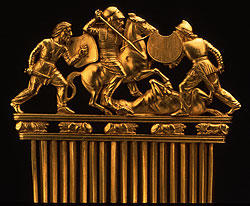The World's First Hippies and Their Marijuana Sauna

One of my favorite ancient historians is the entertaining and garrulous old Greek Herodotus (b. 484 BC), called the "father of history" by some and the "father of lies" by others. Herodotus was famous for reporting what he heard, which was often fantastic. His book centered on the conflict of Greece and Persia, and in so doing, he took the time to explain the customs and geography of the non-Greek world, from the oldest (Egypt) to the youngest (the Scythian nomads). Throughout, his attitude is exemplified by a comment he makes on Persian customs. After describing the Magi's Zoroastrian custom of killing evil animals (those created by the devil Ahriman such as ants, snakes, cats, and so on, unlike cows, dogs, and other good animals created by the good god Ahura Mazda), he says, "Well, it is an ancient custom, so let them keep it" (p. 58).
He also gave the first ethnographic description of a pastoral nomadic people, the Scythians. The Scythians lived in today's Ukraine and Southern Russia, following their herds and living in wagons. In the 600s BC, they invaded the Near East, and so pop up in Jeremiah's prophecies as the Ashkhenaz (see Jer. 51: 24-29). Later on they became the prototypes of Gog and Magog (Ezekiel 38-39 and Revelation 20); any invasion of nomadic peoples was thus seen by medieval Christian, Jewish, and Muslim writers as a sign of the apocalypse. Some Scythians were farmers, however, and in the fifth century BC began to export grain to Greece. (With the money they earned they hired Greek goldsmiths to make the famous Scythian gold.)
When Herodotus sticks to the Scythians (as opposed to their further off neighbors), his account is remarkably accurate -- the section on royal burials has been completely confirmed by archeology (see here, with pretty pictures too). The Scythians spoke an Iranian-type language. Their closely related eastern cousins, the Sarmatians are ancestors of today's Ossetians (much more here; a.k.a. Ossetes), an embattled, mostly Christian, people in the Causasus. Like other Central Eurasian peoples, the Scythians believed that bathing in running water polluted it and so adopted a different practice:
After a burial, the Scythians go through a process of cleaning themselves; they wash their heads with soap, and their bodies in a vapor-bath, the nature of which I will describe. On a framework of three sticks, meeting at the top, they stretch pieces of woollen cloth, taking care to get the joins as perfect as they can, and inside this little tent they put a dish with red-hot stones in it. Now, hemp grows in Scythia, a plant resembling flax, but much coarser and taller. It grows wild as well as under cultivation, and the Thracians [the people of today's Bulgaria, then speaking a now-extinct, non-Slavic, language] make clothes from it very like linen ones -- indeed, one must have much experience in these matters to be able to distinguish between the two, and anybody who has never seen a piece of cloth made from hemp will suppose it to be of linen. They take some hemp seed, creep into the tent, and throw the seed on to the hot stones. At once it begins to smoke, giving off a vapor unsurpassed by any vapor-bath one could find in Greece. The Scythians enjoy it so much that they howl with pleasure. This is their substitute for an ordinary bath in water, which they never use. The women grind up cypress, cedar, and frankincense on a rough stone, and plaster it all over their bodies and faces. They leave it on for a day, and then, when they remove it, their skin is clean, glossy, and fragrant (pp. 238-39).
Like totally far out! And I dig that groovy all-natural beauty treatment the chicks use!
Labels: Central Eurasia, classic histories, Herodotus, Scythians

<< Home